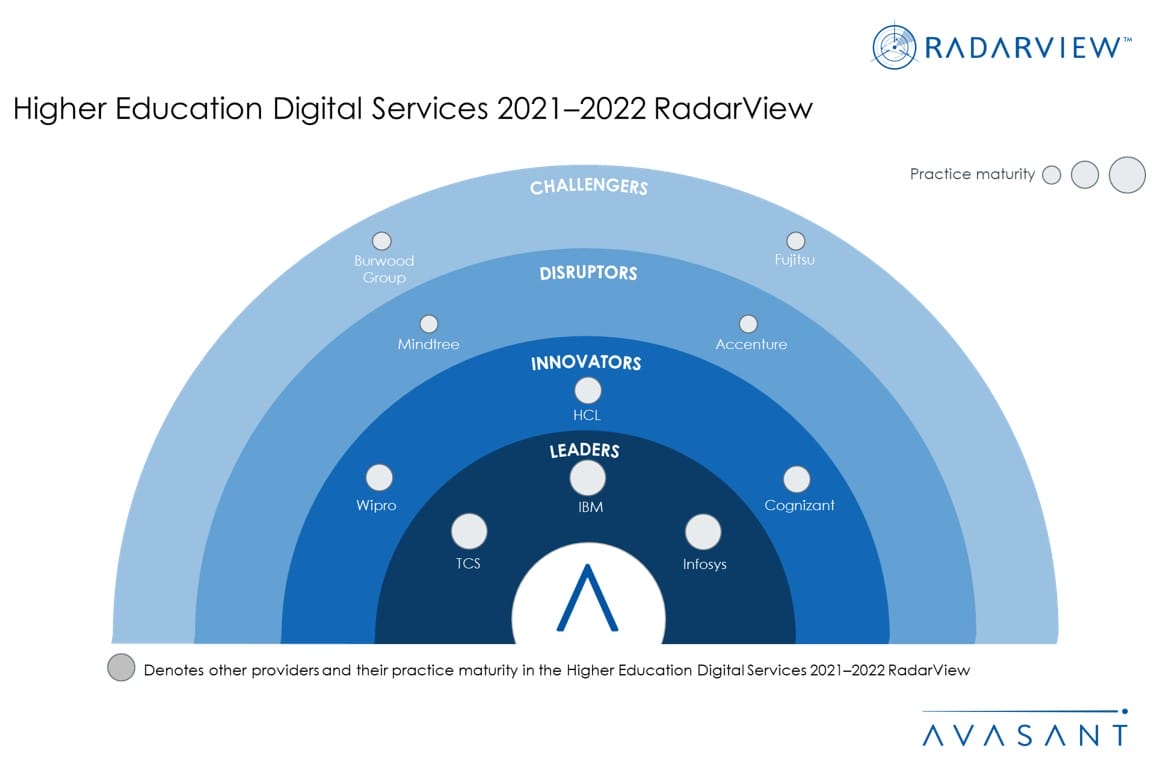Universities have been particularly impacted by the pandemic due to the in-person nature of traditional education. They are responding to this threat by investing in digital technologies such as cloud, artificial intelligence (AI), analytics, immersive learning spaces, and digital curricula. In fact, more than 80% of institutions are allocating over 25% of their 2021 IT budgets toward digital initiatives.
These emerging trends are covered in our Higher Education Digital Services 2021–2022 RadarView™ report. The report is a comprehensive study of digital service providers serving higher ed institutions. It includes top trends, analysis, recommendations, and a close look at the leaders, innovators, disruptors, and challengers in this market.
We evaluated 25 providers across three dimensions: practice maturity, partner ecosystem, and investments and innovation. Of those 25 providers, we recognize 10 that have delivered the most value to the market during the past 12 months.
The report recognizes service providers in four categories:
-
- Leaders: IBM, Infosys, and TCS
- Innovators: Cognizant, HCL, and Wipro
- Disruptors: Accenture and Mindtree
- Challengers: Burwood Group and Fujitsu
Figure 1 from the full report illustrates these categories:

Rob Devers, senior director and senior fellow with Avasant, congratulated the winners noting, “Remote learning will coexist with on-campus education. As institutions accelerate their focus on student diversity and address unique educational needs, it is critical for them to make necessary technological investments to support their teaching models.”
Some of the findings from the full report include the following:
Higher educational institutions should:
- Expand outreach by introducing new models for educating students.
-
- Scale up the development of online courses and digitization of content to enable on-demand access by students across different geographies for remote learning.
- Address the different and specific requirements of students by offering varied models focusing on self-directed learning (flipped classrooms) or specialized learning (skill development).
- Prepare a diligent investment plan for a hybrid university to reduce financial burdens and engage students.
-
- Prioritize investments to facilitate remote learning by focusing on IT capabilities: cloud platforms, collaborative tools, data security measures, AI bots, and analytics-based assessments.
- Redesign campuses for “safe return to campus” by assessing and investing in pandemic-related protocols (thermal screening), networking measures, and livestreaming of lectures from class.
- Double down investment on AI and analytics to enhance overall quality and reimagine the student experience.
-
- Mine data assets and deploy AI and analytical solutions to expedite research projects, develop personalized content, profile and upskill faculty, and enable automated remote proctoring.
- Reimagine the student experience by leveraging AI-based solutions for providing personalized communication, gamifying learning experiences, and employing bots to answer queries.
“Creating differentiated experiences through personalization and immersive education will play a crucial role in the growth of remote learning,” said Avasant’s Research Leader, Pooja Chopra. “Educational institutions should collaborate with EdTech companies and progressive service providers to accelerate digital transformation.”
The full report also features detailed RadarView profiles of the 18 service providers, along with their solutions, offerings, and experience in assisting higher educational institutions in digital transformation.
This Research Byte is a brief overview of the Higher Education Digital Services 2021–2022 RadarView™ report (click for pricing).

